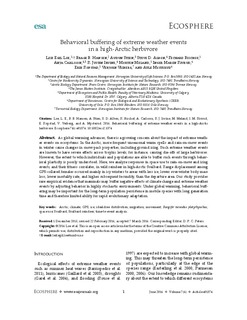Behavioral buffering of extreme weather events in a high-Arctic herbivore
| dc.contributor.author | Loe, Leif Egil | |
| dc.contributor.author | Hansen, Brage Bremset | |
| dc.contributor.author | Stien, Audun | |
| dc.contributor.author | Albon, Steve D. | |
| dc.contributor.author | Bischof, Richard | |
| dc.contributor.author | Carlsson, Anja M. | |
| dc.contributor.author | Irvine, Justin | |
| dc.contributor.author | Meland, Morten | |
| dc.contributor.author | Rivrud, Inger Maren | |
| dc.contributor.author | Ropstad, Erik | |
| dc.contributor.author | Veiberg, Vebjørn | |
| dc.contributor.author | Mysterud, Atle | |
| dc.coverage.spatial | Svalbard | nb_NO |
| dc.date.accessioned | 2016-07-12T12:16:16Z | |
| dc.date.accessioned | 2016-07-13T11:44:33Z | |
| dc.date.available | 2016-07-12T12:16:16Z | |
| dc.date.available | 2016-07-13T11:44:33Z | |
| dc.date.issued | 2016 | |
| dc.identifier.citation | Ecosphere 2016, 7(6) | nb_NO |
| dc.identifier.issn | 2150-8925 | |
| dc.identifier.uri | http://hdl.handle.net/11250/2396447 | |
| dc.description.abstract | As global warming advances, there is a growing concern about the impact of extreme weather events on ecosystems. In the Arctic, more frequent unseasonal warm spells and rain-on- snow events in winter cause changes in snow-pack properties, including ground icing. Such extreme weather events are known to have severe effects across trophic levels, for instance, causing die-offs of large herbivores. However, the extent to which individuals and populations are able to buffer such events through behavioral plasticity is poorly understood. Here, we analyze responses in space use to rain-on- snow and icing events, and their fitness correlates, in wild reindeer in high-Arctic Svalbard. Range displacement among GPS-collared females occurred mainly in icy winters to areas with less ice, lower over-winter body mass loss, lower mortality rate, and higher subsequent fecundity, than the departure area. Our study provides rare empirical evidence that mammals may buffer negative effects of climate change and extreme weather events by adjusting behavior in highly stochastic environments. Under global warming, behavioral buffering may be important for the long-term population persistence in mobile species with long generation time and therefore limited ability for rapid evolutionary adaptation. Arctic; climate; GPS; ice; ideal-free distribution; migration; movement; Rangifer tarandus platyrhynchus; space use; Svalbard; Svalbard reindeer; time-to-event analysis. | nb_NO |
| dc.language.iso | eng | nb_NO |
| dc.rights | Navngivelse 3.0 Norge | * |
| dc.rights.uri | http://creativecommons.org/licenses/by/3.0/no/ | * |
| dc.subject | arctic | nb_NO |
| dc.subject | climate | nb_NO |
| dc.subject | GPS | nb_NO |
| dc.subject | ice | nb_NO |
| dc.subject | ideal-free distribution | nb_NO |
| dc.subject | migration | nb_NO |
| dc.subject | movement | nb_NO |
| dc.subject | Rangifer tarandus platyrhynchus | nb_NO |
| dc.subject | space use | nb_NO |
| dc.subject | Svalbard | nb_NO |
| dc.subject | Svalbard reindeer | nb_NO |
| dc.subject | time-to-event analysis | nb_NO |
| dc.title | Behavioral buffering of extreme weather events in a high-Arctic herbivore | nb_NO |
| dc.type | Journal article | nb_NO |
| dc.type | Peer reviewed | nb_NO |
| dc.date.updated | 2016-07-12T12:16:16Z | |
| dc.subject.nsi | VDP::Mathematics and natural science: 400::Zoology and botany: 480 | nb_NO |
| dc.source.volume | 7 | nb_NO |
| dc.source.journal | Ecosphere | nb_NO |
| dc.source.issue | 6 | nb_NO |
| dc.identifier.doi | 10.1002/ecs2.1374 | |
| dc.identifier.cristin | 1367751 | |
| dc.relation.project | Norges forskningsråd: 216051 | nb_NO |
Tilhørende fil(er)
Denne innførselen finnes i følgende samling(er)
-
Publikasjoner fra CRIStin - NINA [2364]
-
Scientific publications [1392]
Vitenskapelige artikler, kapitler og monografier i Open Access.

